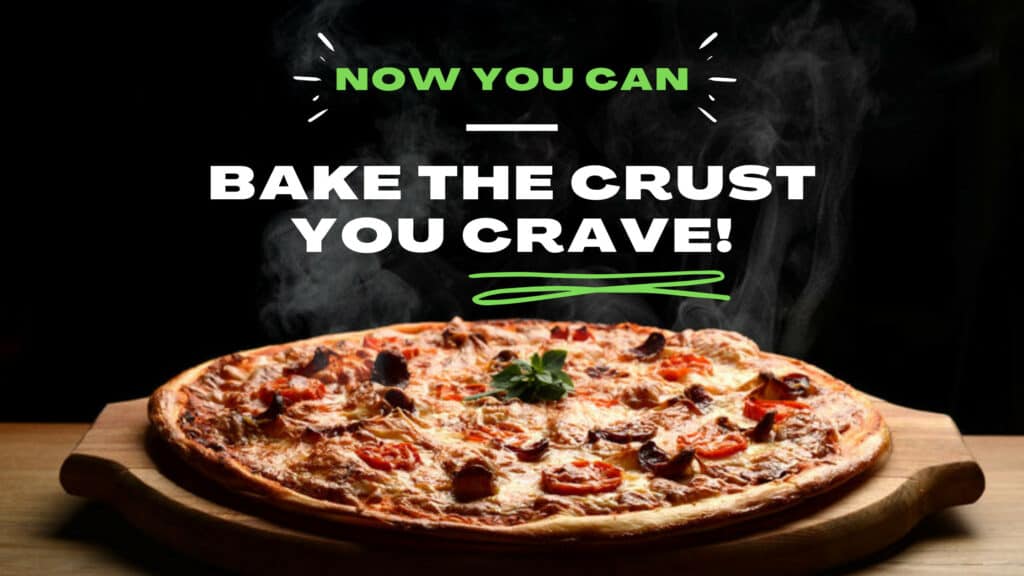Welcome to the fascinating world of pizza making!
If you’ve ever been curious about achieving that irresistible, pizzeria-quality, crispy crust in your homemade pizza, you’ve landed in the right place. The secret? A seemingly simple yet magical kitchen tool – the pizza stone.
So, what is a pizza stone? It’s your ticket to transforming your regular oven into an Italian pizzeria. It’s an investment that can drastically improve your homemade pizzas and various baked goods, from rustic breads to scrumptious pastries.
In this post, we’ll delve into the details of what a pizza stone is, why it’s a game-changer for baking, the science behind how it works, and how to use and care for one.
By the end, you’ll be ready to elevate your homemade pizza game to a whole new level.
Intrigued? Let’s get started on this delicious journey. Continue reading to uncover the incredible potential of the humble pizza stone!
Let’s find out!
Here’s What You Will Find:
A pizza stone, also known as a baking stone, is a culinary tool that is quickly gaining popularity among pizza lovers and home bakers alike. But what exactly is a pizza stone, and why should it find a place in your kitchen?
A pizza stone is essentially a flat, typically round or rectangular slab that is used as a cooking surface for baking food, most notably pizza and bread.
It’s primarily designed to replicate the baking qualities of the traditional brick ovens, which have been used for centuries to create perfectly baked bread and pizza with a delightfully crispy crust.
The origins of the pizza stone can be traced back to the ancient bread-baking methods, where bread was baked on hot stones or brick ovens.
Today, with the help of pizza stones, we can recreate that authentic, wood-fired pizza oven experience right in our home ovens.
The importance and benefits of using a pizza stone are manifold. They allow you to bake pizza with a perfectly crispy crust and ensure an even heat distribution, delivering a consistent bake throughout.
Whether you are a pizza enthusiast looking to upgrade your homemade pizza game or a home baker wanting to perfect your bread baking, knowing about pizza stones will surely elevate your culinary skills.
What is a Pizza Stone?
A pizza stone, also known as a baking stone, is a cooking surface often used for baking food with a crispy crust, such as pizza and bread. The key characteristic of a pizza stone is its material— it’s typically made from ceramic, cordierite, or steel, which can withstand high temperatures and distribute heat evenly.
Pizza stones are generally round or rectangular in shape, mimicking the traditional pizzas made in commercial pizza ovens. They come in various sizes, suitable for different sizes of pizzas and ovens.
What is a Pizza Stone?
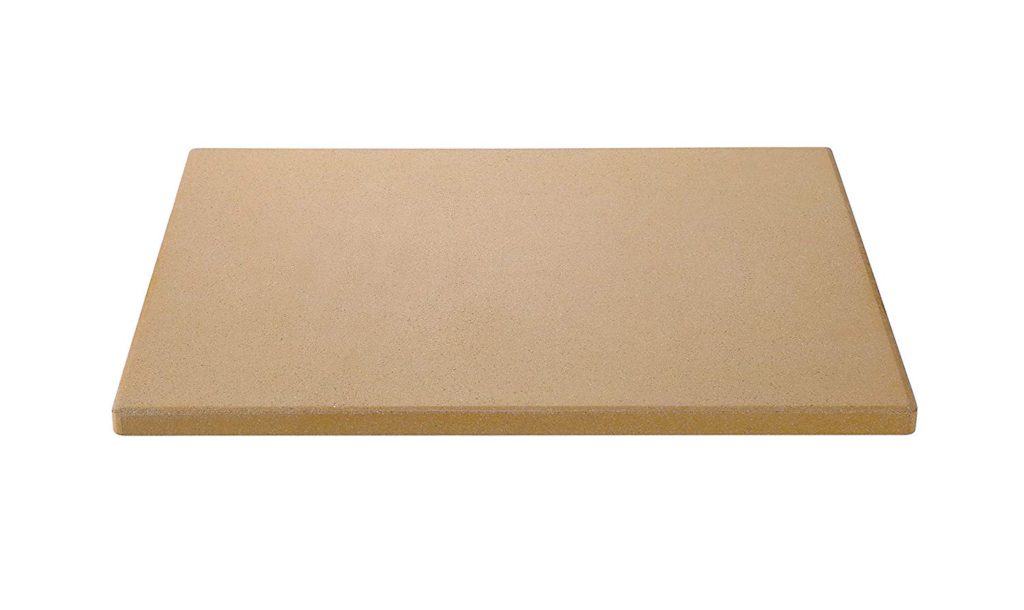
Pizza stones absorb heat quickly and hold it for an extended amount of time. Boosting the temperature and providing an extra-hot surface to bake the pizza, this simulates the effect of a pizzeria’s brick oven.
The greater heat produces a beautiful pizza crust and may reduce baking time to under 10 minutes, allowing you to produce pizzas like a true pizzaiolo.
Baking stones are similar to cookie sheets, except they may absorb more moisture for crispier results.
What is a Baking Stone?
A baking stone, also known as a pizza stone, is a cooking surface typically made from ceramic, cordierite, or steel. The terms are interchangeable. It’s primarily used in baking to provide even, high heat, much like a traditional brick oven.
This results in food, such as pizza or bread, having a well-cooked, crispy crust. Baking stones work by absorbing heat from the oven and then evenly distributing it to the food item placed on it.
In the last few years, pizza stones made of a material such as composite minerals or steel have become popular – more on that later.
Understanding Pizza Stones
Pizza stones are typically made from one of three materials: ceramic, cordierite, or steel. Let’s take a closer look at each.
Materials used in making pizza stones:
- Ceramic: These are the most common types of pizza stones. Ceramic has good thermal mass, which can hold and distribute heat evenly. However, they may not be as durable as other types and can crack under extreme temperature changes.
- Cordierite: This is a mineral known for its heat-resistant properties. Cordierite stones are durable and resistant to thermal shock, making them less likely to crack under high heat or sudden temperature changes than ceramic stones.
- Steel: Steel pizza stones are the most durable and conduct heat the fastest. However, they are typically more expensive than ceramic or cordierite stones.
Check our article What is a Pizza Stone Made Of? for more details.
Different types of pizza stones:
- Round Pizza Stones: These are designed to mimic the shape of a traditional pizza and are perfect for home ovens.
- Rectangular Pizza Stones: These offer a larger cooking surface and are suitable for larger ovens or for baking other items like bread or pastries.
- Pizza Stone Sets: These often come with a pizza peel (a shovel-like tool for putting pizza in and out of the oven) and sometimes even a pizza cutter.
How a Pizza Stone Works
The working of a pizza stone is rooted in its ability to heat up even when placed in a hot oven. When the pizza is placed on the hot stone, the crust begins to cook immediately, mimicking the cooking style of a traditional brick pizza oven.
Here is how you can now bake the perfect crust! You need to get yourself a pizza stone!
Let us explain what is a pizza stone and how it works.
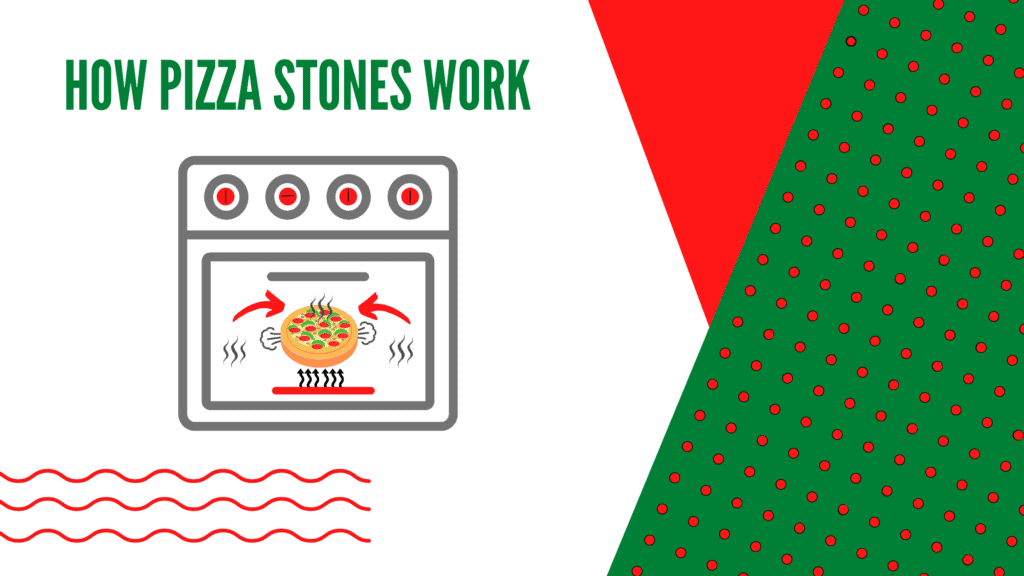
A pizza stone is a flat, typically round, or rectangular slab of ceramic or stone that’s used in a conventional oven, toaster oven, or grill for baking pizza and other dough-based foods.
The principle behind a pizza stone’s function is its ability to heat evenly and hold high temperatures.
When you preheat the stone in the oven, it absorbs and stores the heat energy. Upon placing the pizza on the hot stone, the heat transfers rapidly from the stone to the dough, creating a crispy crust by drawing out the moisture in the dough and encouraging oven spring, which is the rapid rise of the dough when it’s introduced to a high temperature.
This process also creates a perfectly browned top, as the radiant heat from the stone cooks the pizza from the bottom up, allowing the toppings and cheese to cook at a similar rate as the crust.
The stone’s porous material also absorbs excess moisture, ensuring a crisp finish.
Thus, a pizza stone replicates the conditions found in a professional brick oven, allowing you to create restaurant-quality pizza at home.
By baking directly on the hot pizza stone, heat is more efficiently transferred to the bottom of the pizza.
In addition, the steam generated from the cooking dough can more easily escape via the porous stone.
This helps the crust cook up crispier and crunchier than when in contact with a non-porous metal pan.
The Results of Using a Pizza Stone Speak for Themselves

The result is a well-cooked, crispy crust that is hard to achieve with a regular baking sheet.
Science Behind Pizza Stones
To understand why pizza stones make such a difference in the baking process, it’s crucial to understand the basic principles of thermal properties and moisture absorption they possess.
Thermal mass
Thermal mass is a term used to describe the ability of a material to absorb and retain heat. In the context of a pizza stone, it refers to how it can absorb a large amount of heat from the oven and then gradually release it to cook the food.
This slow and steady heat release is ideal for cooking pizza, ensuring a crispy crust and well-cooked toppings.
How Pizza Stones Enhance Heat Distribution
When you preheat a pizza stone in the oven, it gets hot and promotes even heat distribution. Unlike metal pans with hot spots, the stone’s material evenly distributes the heat across its surface.
This ensures that every part of your pizza or bread bakes at the same rate, preventing areas of undercooking or overcooking.
Role of Pizza Stones in Moisture Absorption
Another crucial scientific aspect of pizza stones is their ability to absorb moisture. Most pizza stones are porous, meaning they absorb moisture from whatever is placed on them. When you cook a pizza on it, the stone will absorb some moisture from the dough, which helps to make the pizza crust crispy.
This property is especially useful when baking bread, as it helps to create a hearty, crunchy crust that’s often desirable.
Size and Shape Variations of Pizza Stones
Pizza stones come in various sizes and shapes to suit different types of ovens and pizza sizes. The size of the stone you choose should primarily depend on the size of your oven and the size of pizzas you typically make. Whether round, square, or rectangular, each shape has its own advantage, and your choice would depend on your specific needs and preferences.
How to Use a Pizza Stone
- Preheat the pizza stone to 500 to 550 degrees Fahrenheit for about 45 minutes. If at all feasible, the oven temperature for a pizza stone should be higher than 500° F.
Place a room-temperature pizza in the center of the pizza stone (do not season the stone). - Close the grill lid/oven and cook for 5 minutes.
- Cook for another 5-7 minutes after turning the pizza 180 degrees using a pizza peel.
- Allow the pizza stone to cool in the oven or on the grill before cleaning.
Check our article on How to use a pizza stone for more details or How to use a pizza stone on a grill for more details.
Does a Pizza Stone Make a Difference?
Compared to cooking in a metal pan on an oven rack, there absolutely is a difference. If you already make pizza at home, you may have had a less-than-stellar outcome:
The pizza looks great, but when you look closer and cut into it, you find the dough is not cooked enough.
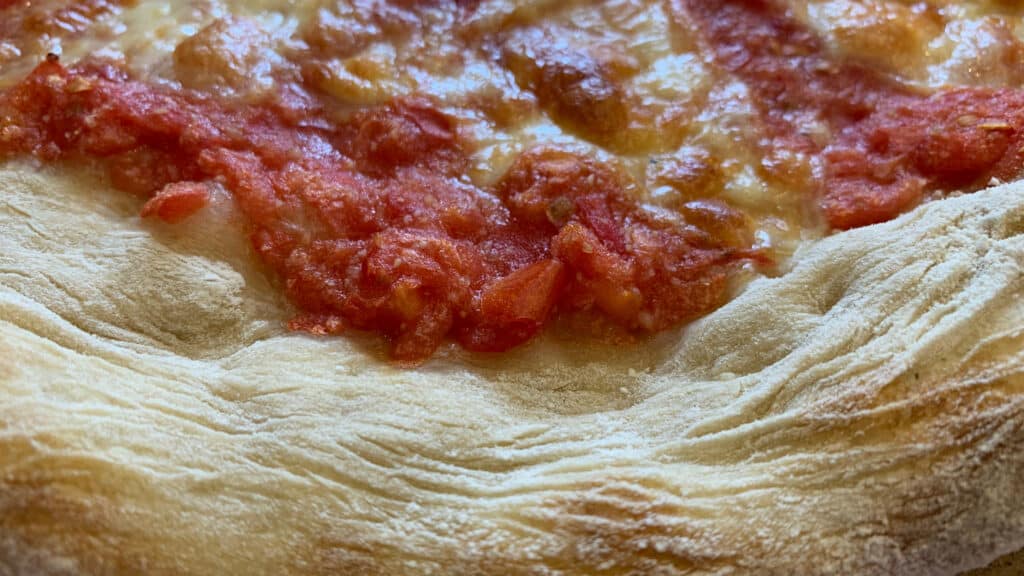
Or the opposite but equally disappointing result: by the time you’ve browned the bottom of the pizza, the toppings are overdone and dried out.
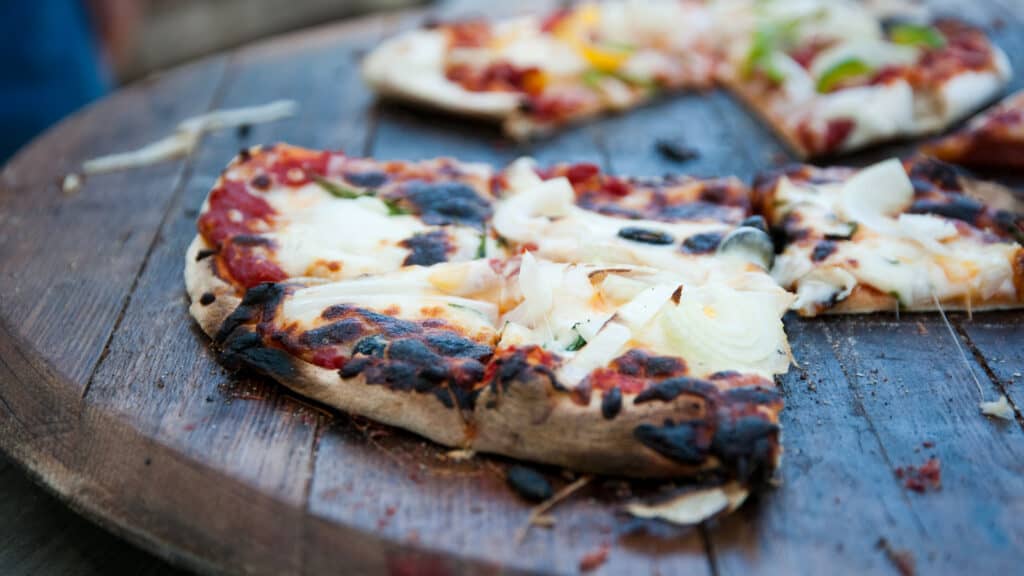
Pizza Pun
What are you if can’t decide what kind of pizza to get?
You’re indeSLICEsive.
Benefits of Using a Pizza Stone
The distinctive cooking properties of pizza stones can significantly enhance your homemade pizza’s texture and flavor. Here’s how:
Comparison of pizza cooked on a stone vs. a regular baking sheet:
When you bake a pizza on a regular baking sheet, the sheet doesn’t hold and distribute heat as effectively as a pizza stone does.
As a result, you may end up with unevenly cooked or undercooked parts, especially in thicker dough pizzas. The heat is evenly distributed across the entire pizza with a pizza stone, ensuring a uniform bake.
The impact of a pizza stone on the texture and flavor of the pizza:
The heat from the stone cooks the pizza dough swiftly, creating a puffy, crispy crust that’s a hallmark of great pizza. The stone’s porous nature also draws out moisture from the dough, enhancing the crust’s crispiness.
This results in a perfectly crisp crust on the outside while remaining soft on the inside. Furthermore, the high heat helps to cook the pizza toppings evenly and quickly, locking in their flavors.
Health benefits
While pizza stones primarily improve the texture and flavor of your pizza, there could be an indirect health benefit.
Cooking pizza at high heat for a shorter duration can help retain more nutrients in the pizza toppings compared to a long cooking process. However, this doesn’t make the pizza healthier in a conventional sense, as the nutritional value of a pizza depends more on the ingredients you use.
Another advantage of using a stone is that the pizza cooks faster, taking only about 6-8 minutes per pie.
Even if you decide to keep your pizza in a pan (as in Chicago or Sicilian style), it’s still a great idea to use a pizza stone for its ability to transfer heat to the pan.
Pro Tip
It is best practice to preheat your pizza stone for at least 1hr before using it. This will give you the best results!
What Features Should You Consider When Buying a Pizza Stone?
Now that you know what is a pizza stone, we’ve got you thinking about getting one, you are probably wondering what to look for in a pizza stone.
First, think about how you see yourself using the stone – either leaving it in the oven most of the day or bringing it out to serve on; your answer may help you decide what features are important for you.
The considerations for buying a pizza stone vs a baking stone are the same.
Pizza Stone Material
What kind of stone is a pizza stone?
Ceramics and Stones
The most common materials are porous ceramic or clay; other choices include enameled ceramic, composite stone material, cordierite (a naturally occurring heat-tolerant mineral), or even salt!
The unglazed stone/clay/ceramic ones have been around the longest in home kitchens and are recommended for those getting started with baking stones.
Want to learn more about pizza stone materials? Check our article “Examining the Anatomy of Pizza Stones” for more information.
Pizza Stone Heat Retention
Regardless of the material, check the temperature range of the pizza stone you plan to buy. It should be rated to at least 550°F; otherwise, it may crack when you crank up your oven.
Check our article on Pizza Stones Heat Retention for more information.
Pizza Stone Size and Shape
Larger rectangular ones give you more baking room but are rather heavy and are, therefore, best left in the oven for the day. If you want to bring the pizza stone to the table to keep your pizza warm, you may choose a smaller round one with a carrying rack.
Some pizza stones are a set of tiles you arrange on the oven rack; this style has the advantage of being easier to move (and perhaps store) and maximizing your baking surface.
However, tiles are not readily moved from oven to table and are thus designed to stay in the oven until cooled (which will take several hours).
Pizza Stone Thickness & Weight
Pizza stone thickness obviously contributes to weight, but that doesn’t mean thinner is better. Higher thickness provides more heat capacity – meaning that it will stay hot even when you are putting the cold dough on it, and you will not need to take any time to reheat between pizzas. Thicker pizza stones may also be less breakable.
Pizza Stone Handles
Handles that are part of the pizza stone itself will get very hot and take up space in the oven that you could use for baking more pizza.
However, round pizza stones sometimes include a metal rack with handles that stay out of the oven but can hold the stone, and this feature can be useful for serving at the table.
These are Our Favorite Pizza Stones
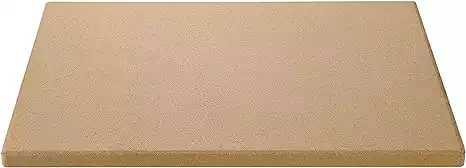 Unicook Heavy Duty Pizza Grilling Stone
Unicook Heavy Duty Pizza Grilling Stone
Unleash the hidden chef in you with the Unicook Heavy Duty Pizza Grilling Stone. This exceptional tool, crafted from durable cordierite material, promises to transform your homemade pizzas into culinary masterpieces. Its thermal shock resistance ensures that it can withstand extreme temperatures, from the high heat of your oven or grill to the cool countertop post-baking.
Heat resistant up to 1,450°F (787°C).
The Unicook Pizza Stone evenly distributes heat for a consistently crisp and beautifully browned crust every time, while its porous surface absorbs excess moisture, bidding goodbye to the dreaded soggy crust. Its considerable size makes it perfect for baking family-sized pizzas, bread, biscuits, and more. Step into a world of unmatched flavor and crispness with the Unicook Heavy Duty Pizza Grilling Stone—your gateway to a home pizzeria experience.
The Original Baking Steel is your secret weapon for recreating pizzeria-quality pizzas right in your home kitchen. Crafted from ultra-conductive steel, this game-changing tool captures and radiates heat with remarkable efficiency, ensuring a perfectly crisp, evenly baked crust every time.
It's not just for pizzas; use it for baking breads, roasting veggies, or even searing meats to culinary perfection. Durable, versatile, and easy to use, the Baking Steel is a true champion of home cooking that will elevate your baking game to professional heights.
Say goodbye to soggy, undercooked crusts and hello to the tantalizing taste of impeccably baked goods with The Original Baking Steel!
How Should You Take Care of Your Pizza Stone?
The maintenance of your pizza stone depends on the material from which it is made. Unglazed, porous stone or ceramics should not be soaked in water and no soap!
Remove any stuck bits with a spatula and/or dry scrub brush; there will likely be black or brown marks on the pizza stone that do not need to come off and contribute to “seasoning” the stone (much like a cast-iron skillet).
For other types of pizza stones, consult the user manual or product information sheet.
What is a Pizza Steel?
Steel and iron slabs are alternatives to a pizza stone that conduct heat more efficiently but are more expensive and require a slightly different cooking technique.
Want to learn more about choosing between a pizza stone and pizza steel? Check our article “The One Thing You Need to Make the Perfect Pizza” for more information.
Here’s What the PROs at Homemade Pizza Pro Use and Recommend
The Original Baking Steel is your secret weapon for recreating pizzeria-quality pizzas right in your home kitchen. Crafted from ultra-conductive steel, this game-changing tool captures and radiates heat with remarkable efficiency, ensuring a perfectly crisp, evenly baked crust every time.
It's not just for pizzas; use it for baking breads, roasting veggies, or even searing meats to culinary perfection. Durable, versatile, and easy to use, the Baking Steel is a true champion of home cooking that will elevate your baking game to professional heights.
Say goodbye to soggy, undercooked crusts and hello to the tantalizing taste of impeccably baked goods with The Original Baking Steel!
What’s the Difference Between a Pizza Stone and a Pizza Steel?
Pizza steels and pizza stones are kitchen tools that mimic the high-heat conditions of a brick oven in your home oven. However, a few distinctions exist between pizza steel and a pizza stone to consider before deciding which to buy.
As their name indicates, pizza steels are constructed of highly conductive steel or cast iron. A pizza stone is a porous material, such as ceramic or cordierite, that absorbs heat to cook a pizza.
Heat conductivity: Because a pizza steel is made of steel, which has a higher heat conductivity than ceramic or cordierite, it heats up faster than a pizza stone. A pizza steel, on the other hand, will cook your pizza faster than a pizza stone.
Cook time: Because pizza steels can get hotter than pizza stones, the cooking time for a pizza made with steel is shorter than that of a pizza made with a stone.
Budget: Pizza stones are generally less expensive than pizza steels, making them an excellent choice for home cooks who make pizzas on a regular basis.
Thermal shock: If your pizza stone is placed in a hot oven and exposed to high heat too quickly, it is more likely to break or shatter due to thermal shock. Pizza steels are made of a heat-resistant, shatter-proof material that will not break.
Extra functionality: Pizza stones and steels are extremely versatile and can be used for various dishes. A pizza stone is ideal for baking various breads, whereas pizza steels may not be suitable for extra-leavened bread.
On the stovetop, pizza steels can be used as a griddle, whereas a pizza stone cannot be used over the burners.
Want to learn more about choosing between a pizza stone and pizza steel? Pizza Stone vs. Pizza Steel.
Do I Need any Other Equipment when Using a Pizza Stone?
We recommend purchasing a pizza peel, a large flat paddle that can be slid under the pizza to get it in and out of the oven.
The Last Slice
Now that you know what is a pizza stone. If you don’t have one yet, you can use the flattest baking sheet you have; if it has a rim, turn it upside down so you can slide the pizza off the pan onto the stone.
Pizza stones are more than just a kitchen gadget; they are a gateway to a whole new level of homemade pizza making. By understanding what a pizza stone is and how it works, we can appreciate the remarkable transformation it can bring to our pizzas.
From its heat-retaining properties to its ability to draw moisture from the dough, a pizza stone is essential for those who love a perfectly crispy crust. It helps achieve the right balance of a crunchy exterior with a soft interior, just like the pizzas from your favorite pizzeria.
Moreover, beyond just pizzas, these stones are a valuable asset for baking various foods, including bread, pastries, and other baked goods, offering you a versatile tool in your baking arsenal.
While the initial investment in a pizza stone might seem hefty to some, the improvement in the quality of your homemade pizzas makes it worthwhile. Not only does it enhance the taste and texture, but it also elevates the entire pizza-making and eating experience.
As we conclude this exploration of pizza stones, we encourage you to try using a pizza stone for your next homemade pizza. Experience the difference and enjoy a truly authentic pizza right from your home oven.
Happy Baking!
Here’s What the PROs at Homemade Pizza Pro Use and Recommend
Why have two pizza peels when you can only have one. This pizza peel surpasses the benefits of wood peels with the convenience of a metal peel. It's made entirely from anodized aluminum for a lightweight design that's incredibly durable, too. It's designed to be used frequently in high-heat pizza ovens.
Alternatives to Pizza Stones
If you don’t want to buy a pizza stone or pizza steel, there are many other alternatives you can use to get good results for your pizza crust.
In our article Powerful Pizza Baking Surfaces, we show you an array of practical solutions, some of which you may already have around your kitchen. So, check it out!
Find 15 alternatives for a pizza baking surface. You may be surprised as some of them you may already own, and some may take you for a spin.
Additional Resources

Best Pizza Stones for Grills in 2023
the PROs
Best Pizza Stones for Grills Do you know which is the best pizza stone for a grill? Pizza stones for …
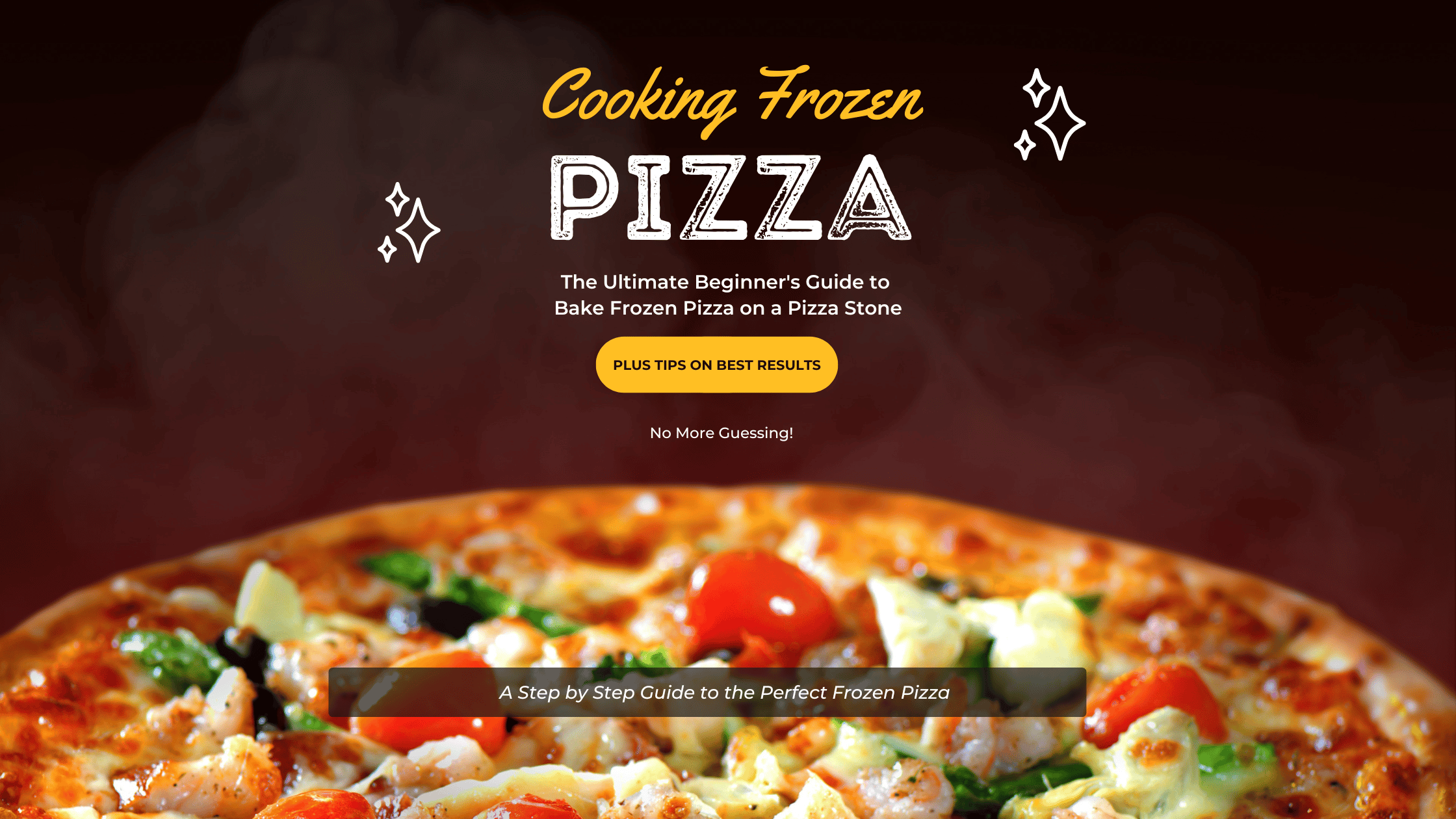
Cooking Frozen Pizza on a Pizza Stone: How to Achieve a Crispy Crust Every Time
the PROs
If you’re looking to elevate your frozen pizza game and achieve that perfect crispy crust, then cooking frozen pizza on …

How to Use a Pizza Stone on a Grill (#1 Beginner’s Guide)
the PROs
How to Use a Pizza Stone on a Grill Quick question: do you know how to use a pizza stone …
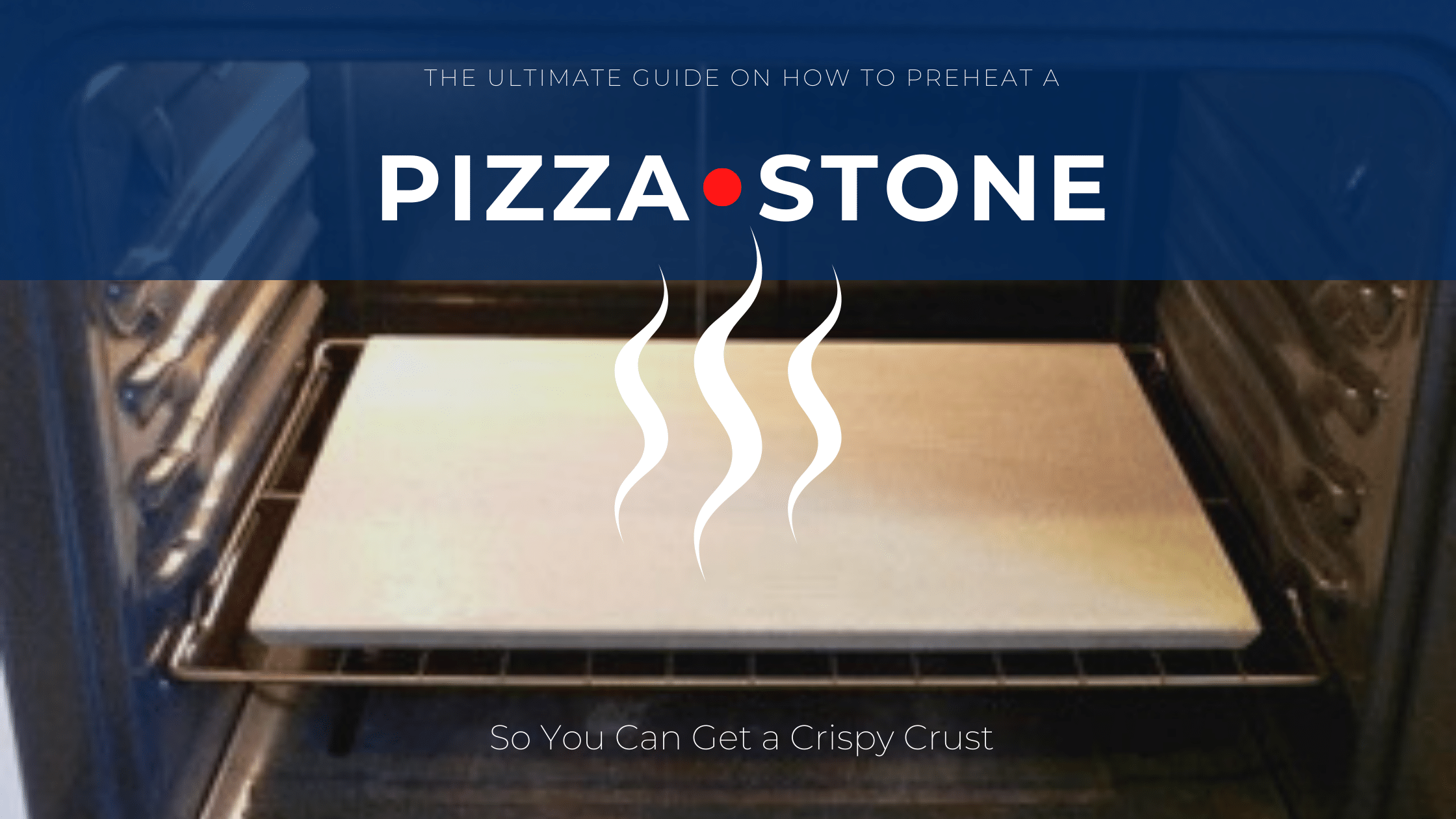
How to Preheat a Pizza Stone: The Ultimate Guide
the PROs
It’s a universally acknowledged truth that nothing quite matches the tantalizing aroma and delectable taste of a homemade pizza, crisped …
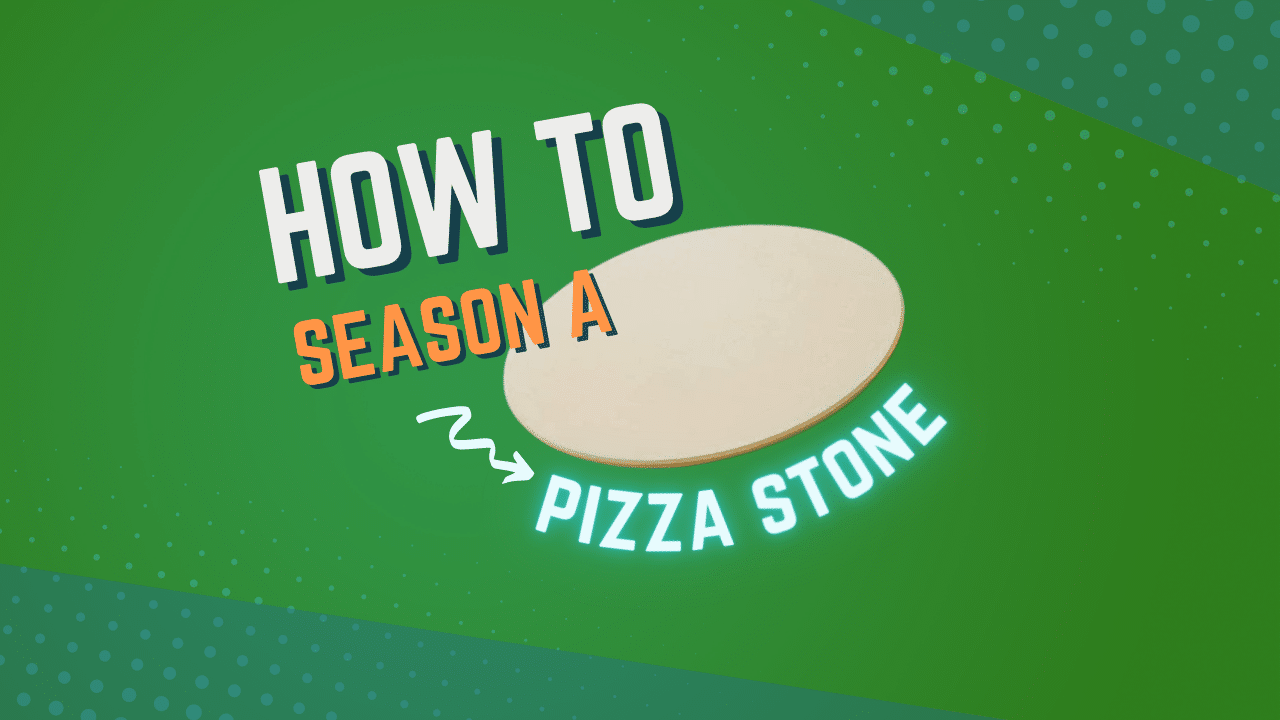
How to Season a Pizza Stone the Right Way!
the PROs
How to Season a Pizza Stone Are you wondering how to season a pizza stone? Today, we’ll look at how …

Everything You Need to Know on How to Use a Pizza Stone for the First Time
the PROs
How to Use a Pizza Stone for the First Time If you are a pizza lover, you may wonder how …
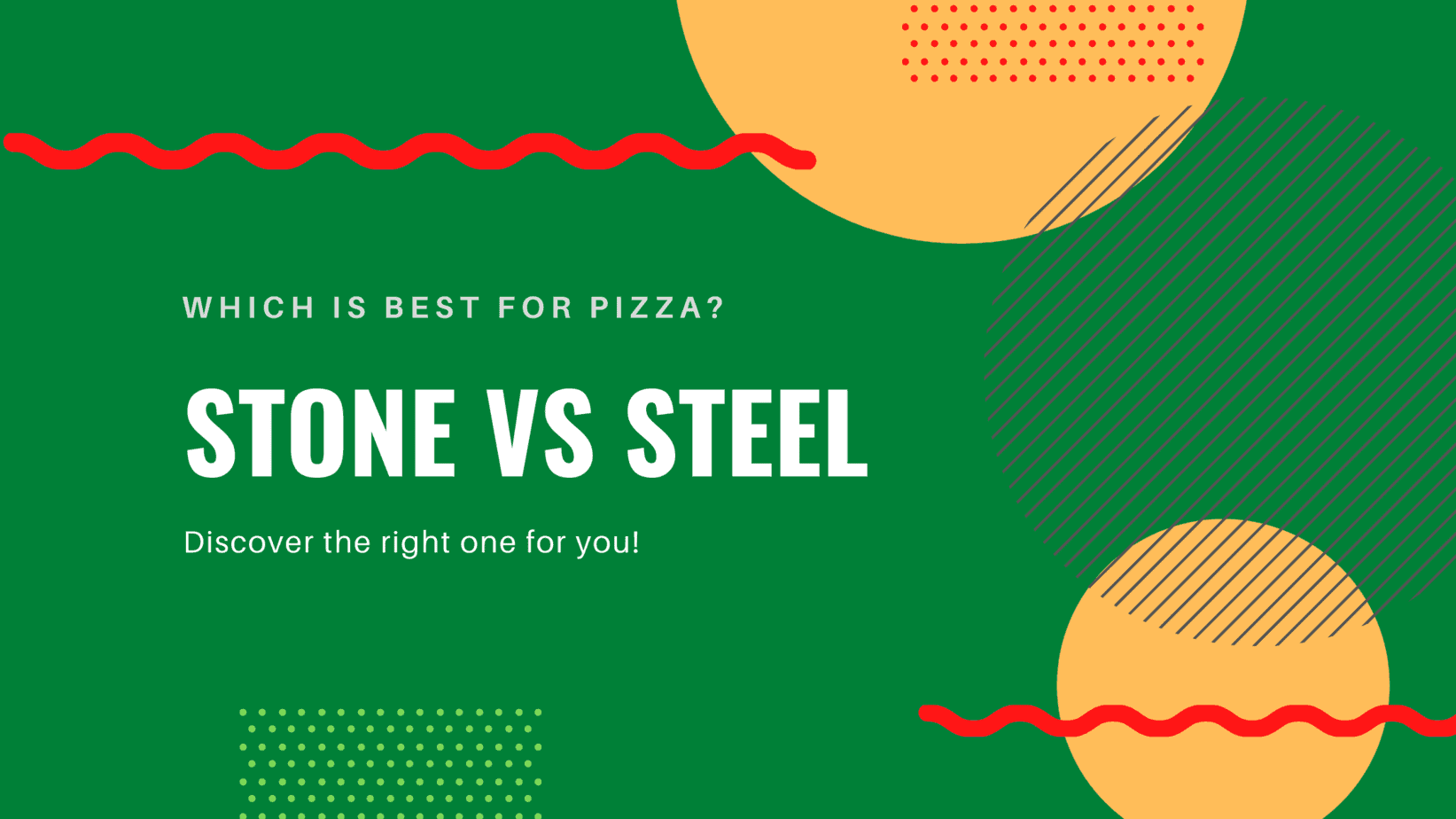
Pizza Stone vs Steel: Discover Which One You Need to Make the Perfect Pizza!
the PROs
Discover the difference between a pizza stone and pizza steel, why you need one, and find which is best for you for the perfect pizza!

Insanely Powerful Pizza Stone Alternatives that will Give You the Best Crust
the PROs
Find 15 alternatives for a pizza baking surface. You may be surprised as some of them you may already own and some may take you for a spin.
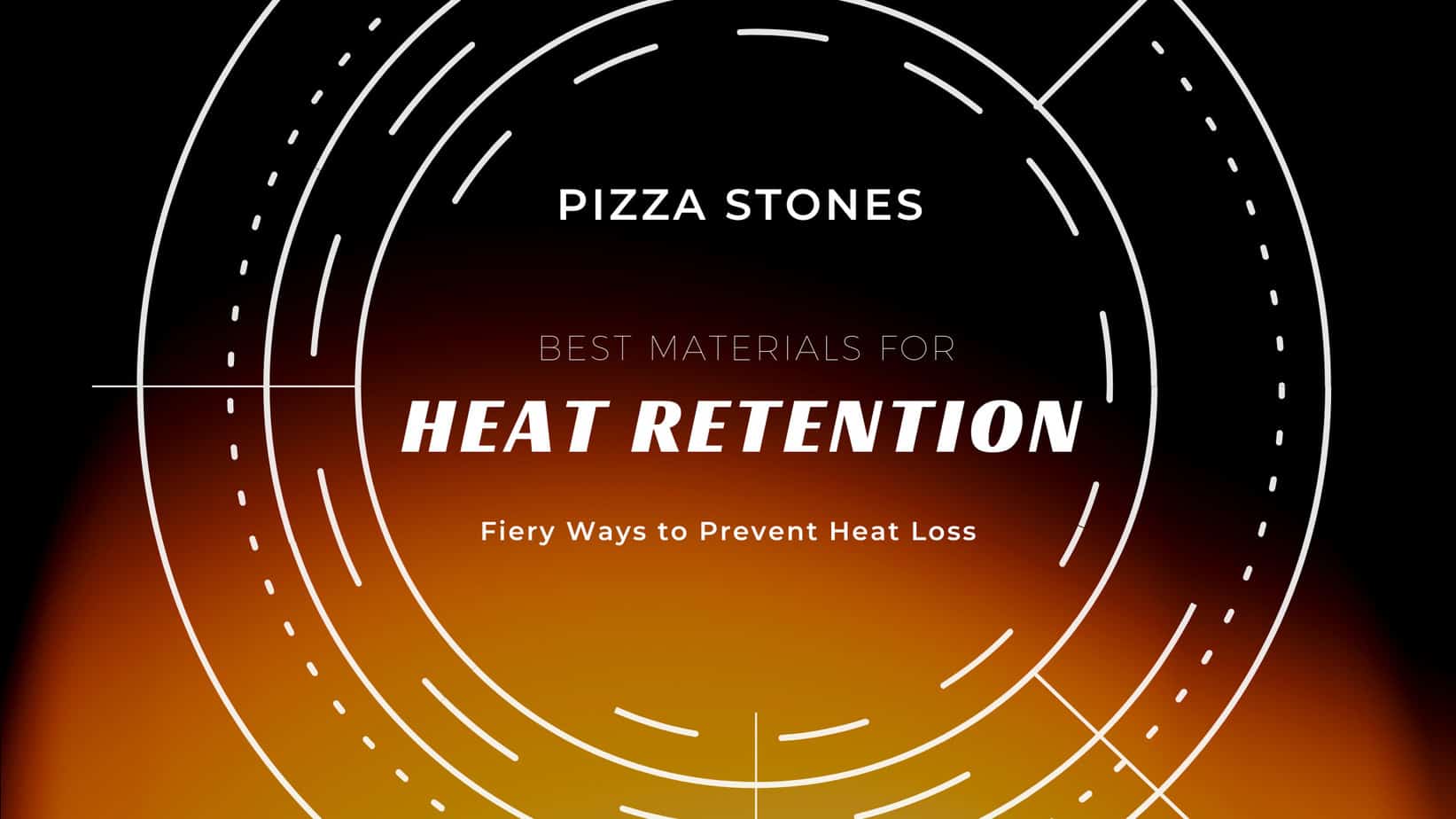
Pizza Stone Heat Retention [Best Pizza Stone Material]
the PROs
Read about pizza stones heat retention and distribution properties, their pros and cons, and which stone might work best for you!
Enjoy!
Not a PRO? Not a Problem!
Take a pizza class to bring your pizza skills to the next level,
so you can be a PRO!
Related Posts

Costco Pizza Delivery: Find How You Can Get It Now!
the PROs
People go to Costco’s food court for many different reasons, but the cheesy slice of pizza they serve is among …

Pizza for Beginners: Don’t Buy Pizza, Make It! Here’s How to Get Started!
the PROs
You have this idea that you want to make pizza at home as opposed to ordering it, but where do you start? Don’t worry! Here you will find answers and directions to all your questions.

Pizza Toppings Under Cheese or Over Cheese? [Why the Order Matters]
the PROs
Is Pizza Cheese on Top or Bottom? Hey pizza lovers, are you wondering if you should layer pizza toppings under …
Newsletter
Subscribe to our Recipe of the Week newsletter and receive our partners’ latest recipes, tips, and discount offers.
Keep in Touch!
